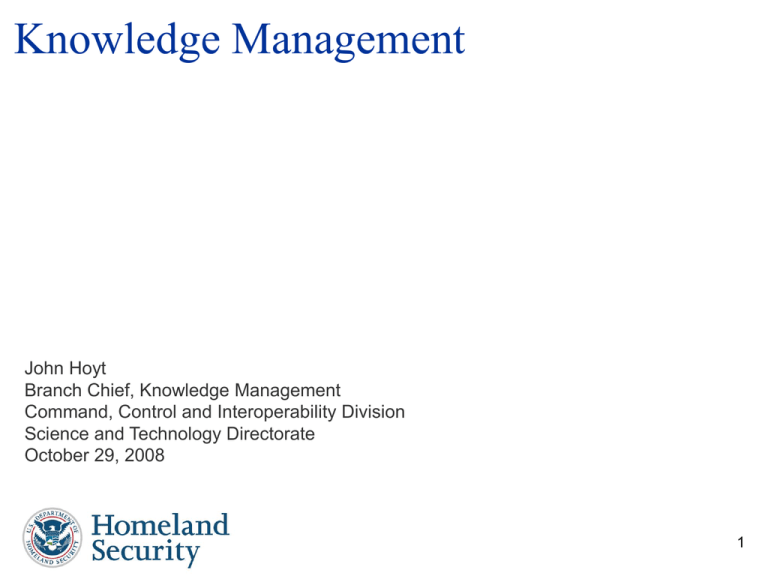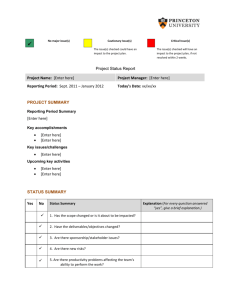DHS Science and Technology Directorate's Programs
advertisement

Knowledge Management John Hoyt Branch Chief, Knowledge Management Command, Control and Interoperability Division Science and Technology Directorate October 29, 2008 1 Command, Control and Interoperability CNR Annual Program Status Review 8 February 2005 Mission Through a practitioner-driven approach, the Command, Control and Interoperability Division (CID) creates and deploys information resources to enable seamless and secure interactions among homeland security stakeholders. Vision Stakeholders have comprehensive, real-time, and relevant information to create and maintain a secure and safe Nation. 2 CID: Organization Managed by the Department of Homeland Security’s (DHS) Science and Technology Directorate, CID delivers on its mission through five thrust areas. Command, Control and Interoperability (CID) Cyber Security Reconnaissance, Surveillance, and Investigative Technologies Communication, Interoperability and Compatibility Basic/Futures Research Knowledge Management Tools 3 Knowledge Management Tools • Provides knowledge management capabilities to reduce the risk of terrorist attacks and to prepare for and respond to natural and man-made disasters. • Develops tools and methods to process and analyze massive amounts of information that are widely dispersed and in multiple forms. • Works collaboratively to complement efforts in the intelligence, law enforcement, and homeland security communities. 4 Regional Information Sharing and Collaboration EHC IS-FY09-01: Real-Time Data Processing and Visualization Gap: ISG-07-07v1 – Require on-demand management, analysis, and visualization of information in multiple forms and from diverse, distributed sources Product Description • Develop and evaluate information sharing technologies to support cooperative efforts of local, state, and Federal government entities. Transitioned Regional Information Sharing and Collaboration products include temporal and criminal activity network visualization tools and wireless federated query applications • Deliverable Type: New Technology Planned Demos/Deliverables/Transitions • Deliverable 1: Conduct interstate photo sharing pilot with North Carolina, South Carolina, Virginia law enforcement agencies – FY 2008-2009 • Deliverable 2: Evaluate handhelds and wireless federated query applications in integrated local, state, and Federal law enforcement information sharing environments (Automated Regional Justice Information System, AZLink) – FY 2008-2010 • Transition 3: Interconnect fragmented regional systems using existing public safety network infrastructure and nonproprietary software components – FY 2009-2012 Homeland Security Payoff • Improves ability of law enforcement and other emergency agencies to protect U.S. citizens against terrorism, national disasters, and criminal acts • Customers: Customs and Border Protection (CBP); Immigration and Customs Enforcement (ICE); 250 other local, state, and Federal law enforcement organizations via Nlets (International Justice and Public Safety Network), Automated Regional Justice Information System, and AZLink • Stakeholders: Other law enforcement organizations 5 National Information Exchange Model EHC IS-FY09-02: Threat Dissemination Standards Gap: ISG-07-18av1 – Lack of standards and protocols for rapidly sharing information within sectors and across sectors to defeat terrorist threats Product Description • Support the Department of Homeland Security (DHS) National Information Exchange Model (NIEM) implementation team with the identification, refinement, and evaluation of development tools and other technologies to support NIEM data model utilization across the homeland security community • Deliverable Type: Technical Report, Requirements Generation Planned Demos/Deliverables/Transitions • Deliverable 1: Draft technical report for current and planned state with recommended approach to follow-up work – FY 2008 • Deliverable 2: Conduct market survey; provide improved tool recommendations – FY 2008 • Deliverable 3: Develop NIEM tools requirements analysis – FY 2009 • Deliverable 4: Design technology specifications for threat assessment and mitigation exchange standards – FY 2010 • Deliverable 5: Pilot information exchange standards and protocols in development environments – FY 2011 • Deliverable 6: Conduct impact study on current NIEM model; recommend development strategy for element-level tagging – FY 2012 Homeland Security Payoff • Improves NIEM development tools to provide a more robust information exchange process across the DHS enterprise • Customers: DHS Chief Information Officer and Enterprise Data Management Office • Stakeholders: DHS-wide users of NIEM and Information Exchange Package Documentation 6 Critical Infrastructure Inspection Management System EHC IS-FY09-02: Threat Dissemination Standards Gap: ISG-07-18av1 – Lack of standards and protocols for rapidly sharing information within sectors and across sectors to defeat terrorist threats Product Description • Prototype information management system for law enforcement aviation units to effectively manage critical infrastructure inspection prioritization, data collection, data storage, and intelligence interfacing • Deliverable Type: New Technology, Requirements Generation Planned Demos/Deliverables/Transitions • Deliverable 1: Deploy Critical Infrastructure Inspection Management System (CIIMS) to the Maryland State Police and Los Angeles Police Department (LAPD) Aviation Support Division – FY 2008 • Deliverable 2: Develop functional requirements report for broader applications of CIIMS– FY 2008-2009 • Deliverable 3: Develop plan and recommendations report to evolve CIIMS for broader applications – FY 2009 • Deliverable 4: Evolve CIIMS to support the broader law enforcement community and function on other platforms (e.g., cars, boats, on foot) – FY 2010-2013 Homeland Security Payoff • Assists aerial law enforcement in protecting Critical Infrastructure/Key Resources through structured monitoring, data collection, and information sharing within the local, state, and Federal intelligence communities • Customers: Maryland State Police and LAPD • Stakeholders: Office of Infrastructure Protection and National Protection and Programs Directorate (NPPD) 7 Identity Management Testbed – Knowledge Products EHC IS-FY09-03: Network Identity Management Gap: ISG-07-08v1 – Lack of scalable technologies, standards, and policies to manage identities, rights, and authorities in an organization's networks Product Description • Test, pilot, and validate an ongoing stream of technology, process and policy concepts, and solutions related to an Identity Management (IdM) infrastructure. • Based on the operational needs of components, provide guidance on synchronizing IdM approaches across DHS • Deliverable Type: Knowledge Products Planned Demos/Deliverables/Transitions • Deliverable 1: Identity Management Test Bed established at Johns Hopkins University Applied Physics Laboratory to test, pilot, and validate IdM concepts – FY 2008 • Deliverable 2: Test and evaluate emerging IdM technologies; topics include extensible access control markup language, access control, secure token service, fine grained authorization, and malicious internal user simulation – FY 2009-2014 Homeland Security Payoff • Enhances security of DHS information sharing environments by improving authentication for persons, hardware devices, and software applications • Customers: ICE, Transportation Security Administration, United States Coast Guard, DHS Office of Intelligence and Analysis (I&A), Federal Emergency Management Agency (FEMA) • Memorandum of Understanding (MOU) Status: Signed 8 Sea, Lake, Overland Surge Due to Hurricane EHC IS-FY09-05: Data Fusion Technologies Gap: ISG-07-02v1 – Lack integrated technologies and standards for fusing data from multiple sensors to support threat identification and decision analysis Product Description • Model and analyze the National Hurricane Center’s legacy software for hurricane surge prediction to enable modernization and to improve the efficiency and capability of the Sea, Lake, Overland Surge Due to Hurricane (SLOSH) system • Deliverable Type: Modeling and Simulation, Technical Reports, Technical Studies Planned Demos/Deliverables/Transitions • Deliverable 1: Broaden Universal Markup Language model of software – FY 2008 • Deliverable 2: Analyze alternative methods to improve SLOSH software system – FY 2008 • Deliverable 3: Publish specification/design for enhancements to SLOSH model and display program – FY 2008 • Deliverable 4: Update code – FY 2008 • Deliverable 5: Enhance display program – FY 2009 • Deliverable 6: Automate verification/validation process – FY 2010 Homeland Security Payoff • 30% performance improvement of SLOSH model • Enables faster turn-around in surge height prediction output, covering more specific landfall locations and incorporating forecasting updates more quickly into the emergency management decision process • Customer: FEMA • Stakeholders: National Oceanic and Atmospheric Administration 9 Emergency Operations Center EHC IS-FY09-05: Data Fusion Technologies Gap: ISG-07-02v1 – Lack integrated technologies and standards for fusing data from multiple sensors to support threat identification and decision analysis Product Description • Determine core EOC requirements, review solution options, and produce an Emergency Management Operations Toolkit • Deliverable Type: Requirements Generation Planned Demos/Deliverables/Transitions • Deliverable 1: Develop Mid-Atlantic Region Requirements Communications and Interoperability White Paper – FY 2008 • Deliverable 2: Develop Emergency Operations Center Resource Management Requirements-based White Paper – FY 2008 • Deliverable 3: Develop EOC Command and Control Requirements White Paper – FY 2008 • Deliverable 4: Develop Emergency Operations Analysis Paper – FY 2008 • Deliverable 5: Develop Emerging Requirement Analysis Papers – FY 2009-2010 Homeland Security Payoff • Provides and supports interoperability framework and integrates multiple information sharing systems • Supports situational awareness and innovative exercise concepts and exercise platforms • Customers: Local, state, and Federal EOCs 10 Fusion Center Concept Pilot EHC IS-FY09-05: Data Fusion Technologies Gap: ISG-07-02v1 – Lack integrated technologies and standards for fusing data from multiple sensors to support threat identification and decision analysis Product Description • Conduct operational evaluation of current fusion center technologies to baseline existing capabilities and needs • Develop catalogue of common fusion center tools for information sharing, geospatial analysis, suspicious activity reporting, and case management requirements • Deliverable Type: Knowledge Product Planned Demos/Deliverables/Transitions • Deliverable 1: Assess and prioritize IT tool requirements with fusion centers– FY 2009 • Deliverable 2: Evaluate current fusion center technologies aligned with prioritized operational requirements – FY 2009 • Deliverable 3: Structured evaluation of the ability of existing GOTS/COTS tools to fill fusion center needs, with leave behind – FY 2009 • Deliverable 4: Identify gaps/needs for future R&D – FY 2009 Homeland Security Payoff • Establishes technical need/capability baseline that improves the future development and integration of technologies within the fusion centers • Customer: DHS I&A State and Local Fusion Center Program Office 11 Systems Integration and Engineering for Regional Awareness EHC IS-FY09-05: Data Fusion Technologies Gap: ISG-07-02v1 – Lack integrated technologies and standards for fusing data from multiple sensors to support threat identification and decision analysis Product Description • Establish capabilities to support end-user situational awareness and interoperability-related needs through the facilitation of incident management and policy coordination within the National Capital Region (NCR) • Deliverable Type: Technical Studies, Technical Report, Requirements Generation Planned Demos/Deliverables/Transitions • Deliverable 1: Identify functional requirements to establish a 24/7 Federal Coordination Center (FCC) for the FEMA Office of NCR Coordination – FY 2008 • Deliverable 2: Develop operational checklist for the FCC’s first hour of operation – FY 2008 • Deliverable 3: Develop a Concept of Operations document that details how to use FCC technologies – FY 2009 • Deliverable 4: Develop Mission Blueprint with core system requirements, future technical requirements, and recommendations of technical needs for Response Coordination Centers – FY 2009-2010 Homeland Security Payoff • Ensures that incident information, including situational awareness and resource status information, is shared across local, regional, state, and Federal organizations • FEMA has obligated funding for this project: $150K in FY 2008 and $300K in FY 2009 • Customer: FEMA Office of the NCR 12 Multiple Visualization Initiative EHC IS-FY09-08: Law Enforcement and Intelligence Sensor Fusion Gap: ISG-07-02cv1 – Comprehensive sensor fusion between law enforcement and intelligence partners in support of the Common Operational Picture (COP) for threat identification and decision analysis Product Description • Demonstrate an open standards-based information sharing solution for multiple visualization (Geospatial Information System [GIS]) environments • Deliverable Type: Requirements Generation, New Technology Planned Demos/Deliverables/Transitions • Deliverable 1: Analyze requirements; review applicable GIS standards – FY 2009 • Demo 1: Conduct proof of principal for Google and MS Virtual Earth integrated environment – FY 2009 • Demo 2: Expand proof of principal to other visualization environments – FY 2009 • Demo 3: Demonstrate data interoperability at all levels of selected GIS environments – FY 2009 • Transition Path: Other Homeland Security Payoff • Demonstrates the ability to share geographic information through an open standards-based solution, independent of the type of GIS products used • Customer: NPPD • TTA Status: Pending 13 Community Safeguard EHC IS-FY09-08: Law Enforcement and Intelligence Sensor Fusion Gap: ISG-07-02cv1 – Comprehensive sensor fusion between law enforcement and intelligence partner in support of COP for threat identification and decision analysis Product Description • Pilot a range of technologies integrated with a GIS. Technologies include: Smart Closed Circuit television (CCTV), Automatic License Plate Recognition (ALPR), digital dashboard, infrastructure inspection, Automatic Vehicle Locator (AVL), and link analysis software • Deliverable Type: Requirements Generation, New Technology Planned Demos/Deliverables/Transitions • Deliverable 1: Analyze requirements – FY 2009 • Deliverable 2: Conduct technology survey; develop recommended implementation plan for select technologies – FY 2009 • Demo 3: Establish functional, integrated pilot at Beverly Hills Police Department (CCTV, ALPR, Digital Dashboard) – FY 2009 • Demo 4: Demonstrate additional data sources integration (AVL, Radio Over Wireless Broadband) – FY 2010 Homeland Security Payoff • Demonstrates visualization technologies, information sharing protocols, and communications standards in a GIS context to improve situational awareness and incident response • Customer: Beverly Hills Police Department • Memorandum of Agreement Status: Draft with Beverly Hills Police Department 14 Keeping Schools Safe EHC IS-FY09-08: Law Enforcement and Intelligence Sensor Fusion Gap: ISG-07-02cv1 – Comprehensive sensor fusion between law enforcement and intelligence partners in support of COP for threat identification and decision analysis Product Description • Optimize the application of current technologies to existing school safety procedures. Consists of a requirements capture effort, technology assessment of applicable school safety technologies, proof of principal in an integration lab, and final demonstration • Deliverable Type: Requirements Generation, New Technology Planned Demos/Deliverables/Transitions • Deliverable 1: Analyze requirements – FY 2009 • Deliverable 2: Conduct technology survey; develop recommended implementation plan for select technologies – FY 2009 • Demo 1: Conduct proof of principal for selected technologies at Space and Missile Defense Command Integration lab – FY 2009 • Demo 2: Conduct field demonstration of operational school environment – FY 2009 Homeland Security Payoff • Identifies areas where added technology will provide timely information to decision makers and senior officials in the school system • Customer: Alabama Department of Education • Stakeholders: Other state and local educational and public safety organizations 15 Threat Probability Distribution Mapping EHC IS-FY09-09: Cross Target Threat Awareness Gap: IS-07-03v1 – Lack of technologies for correlating information regarding terrorist attack attempts across potential targets to create broad terrorist threat awareness Product Description • Demonstrate the ability to discern patterns and interrelationships between factors or events; counteract threats and identify trends in terrorist or criminal Tactics, Techniques, and Procedures • Deliverable Type: Decision Support Tool, Situational Awareness, and Response Technology Planned Demos/Deliverables/Transition • Deliverable 1: Design analytic techniques and pattern recognition concept of operations and technical architecture – FY 2009 • Deliverable 2: Synthesize predictive analytics and spatial terrain for pre-determined data sets (consequence modeling) – FY 2009 • Deliverable 3: Deploy trained analysts to fusion centers for operational Predictive Analytics Cell – FY 2009 • Transition 4: Conduct operational tests and evaluations; transition to customers – FY 2010 Homeland Security Payoff • Provides actionable intelligence and the ability to synthesize data across the agency for improved situational awareness and critical decision making • Correlates existing law enforcement data with hypothesized threat scenarios • Anticipates national security threats • Customer: DHS I&A State and Local Fusion Center Office 16 Data Privacy and Policy Technology EHC IS-FY09-10: Data Privacy Protection Technology Gap: ISG-07-12v1 – Need to protect U.S. citizens’ data to ensure compliance with intelligence oversight and privacy regulations Product Description • The Massachusetts Institute of Technology (MIT) data use policy evaluation tool analyzes policies associated with data from disparate sources and provides feedback on policy issues • Use MIT tool and scenarios to evaluate a state/urban area fusion center’s information sharing policy guidelines for products developed using local, state, Federal, and private sector data • Evaluate whether local, state, Federal, or private sector policies impact information sharing by a fusion center • Deliverable Type: Knowledge Product Planned Demos/Deliverables/Transitions • Deliverable 1: Assess policy tool and scenario – FY 2009 • Deliverable 2: Identify/develop process to identify policy impediments to information sharing in a multi-information flow (local, state, Federal, and private sector) environment – FY 2009 Homeland Security Payoff • Proposes a process for identifying policy impediments to information sharing • Customers: Program Manager – Information Sharing Environment, DHS I&A State and Local Fusion Center Program Office • MOU Status: Draft with S&T 17 Data Privacy Preserving Technology EHC IS-FY09-01: Cross-Agency Information Distribution Gap: ISG-07-12v1 – Need to protect U.S. citizens’ data to ensure compliance with intelligence oversight and privacy regulations Product Description • Identify, validate, and prioritize engineering and technology • Develop a tool/coding capability that can be inserted into existing systems and automate privacy rule sets • Identify and tag Personally Identifiable Information Planned Demos/Deliverables/Transitions • Deliverable 1: Generate privacy tool requirements – FY 2009 • Deliverable 2: Develop privacy tool system – FY 2009 • Deliverable 3: Test and evaluate privacy tool system – FY 2009 Homeland Security Payoff • Provides DHS analysts with the ability to use U.S. citizens’ data to ensure compliance with intelligence oversight and privacy regulations • Customer: DHS I&A • Stakeholders: DHS Privacy Office 18 CUI Implementation Framework Test and Evaluation EHC IS-FY09-11: Secure Multilevel Information Dissemination Gap: IS-07-29v1 – Advanced techniques are required to support distribution of intelligence products to local, tribal, state, and industrial homeland security mission partners Product Description • Assess capabilities of Controlled Unclassified Information (CUI) producers/consumers to meet safeguarding requirements and estimate costs of addressing safeguarding shortfalls • Evaluate the CUI framework and the applicability/clarity of specified dissemination instructions across multiple types of CUI information, communication channels, and end-user communities • Deliverable Type: Knowledge Products, New Technology Planned Demos/Deliverables/Transitions • Demo 1: Include CUI element in Golden Phoenix training event – FY 2008 • Demo 2: Include CUI element in Dam Sector exercise – FY 2008 • Deliverable 1: Conduct comparative scenario-based exercises to evaluate implementation of the CUI framework – FY 2008-2009 • Deliverable 2: Provide CUI implementation support; conduct multilevel security technology pilots – FY 2010 2013 Homeland Security Payoff • Enables secure, accurate, timely, thorough distribution of DHS-developed intelligence products to external homeland security partners • Improves coordinated threat assessment and mitigation activities • Customers: NPPD, CBP, DHS Office of Security 19 Symbology Standardization Support EHC IS-FY09-06: Maritime and Law Enforcement Information Sharing Protocols Gap: ISG-07-02dv1 – Poor Infrastructure in place to effectively share information that would build the collective situational awareness between maritime, law enforcement, and intel partners Product Description • Survey and document DHS symbology requirements for the Geospatial Management Office. Currently, only point symbols in an emergency response context exist for DHS • Deliverable Type: Technical Services Planned Demos/Deliverables/Transitions Homeland Security Payoff • Deliverable 1: Survey and formally document DHS symbology requirements; provide implementation recommendations – FY 2009 • Deliverable 2: Implement recommendations – FY 2010 • Builds a common symbology base for use across the DHS enterprise • Customers: DHS Office of the Chief Information Officer, Office of Applied Technology • Terms of Agreement Status: Signed • Stakeholders: All DHS components 20 Generalized Data Driven Analysis and Integration EHC IS-FY09-01: Real Time Data Processing and Visualization Gap: ISG-07-07v1 – Require on-demand management, analysis, and visualization of information in multiple forms and from diverse, distributed sources Product Description Develop link analysis, relational data cube, geo-spatial visualization, and statistical analysis technology components for the ICE Pattern Analysis and Information Collection System (ICEPIC) Deliverable Type: New Technology Graphic Planned Demos/Deliverables/Transitions Homeland Security Payoff • Transition 1: Implement Everest visualization tool, LeadTrack proximity query, and Student and Exchange Visitor Information System data cube – FY 2008-2009 • Transition 2: Integrate handheld access, anomaly detection, and cube-to-link analysis; rollout to field – FY 2009-2010 • Transition 3: Conduct spatial/temporal trend analysis – FY 2010-2011 • Transition 4: Conduct entity extraction from reports, trend visual analytics, semi-automatic view discovery – FY 2011-2012 • Transition 5: Conduct entity disambiguation, deploy analysis to field, integrate multi-directional tool – FY 2012-2013 • Enables discovery of hard-to-find or previously undiscovered relationships across ICE enterprise data repositories • Improves field personnel resource management capabilities • Customer: ICE • Stakeholders: Office of Operations Coordination, United States Coast Guard 21 Mission-Based Analysis of Departmental SAR EHC IS-FY09-04: Suspicious Activity Reporting Gap: IS-054 – Lack of visibility, in real time, across agencies of specific encounters of individuals on watch lists and other suspicious activities Product Description Evaluate existing Suspicious Activity Reporting (SAR) methodologies and provide a mission-based assessment for an integrated and more effective approach to sharing and analyzing SAR data Demonstrate an enterprise SAR analytics Proof-ofConcept Deliverable Type: Knowledge Products, Technical Evaluation Graphic Planned Demos/Deliverables/Transitions Homeland Security Payoff • Deliverable 1: Develop SAR component and enterprise technical capability reports – FY 2008-2009 • Deliverable 2: Leverage analysts/analytic software for cross-component SAR analysis – FY 2009 • Transition 1: Develop enterprise SAR technical proof-ofconcept – FY 2009 • Deliverable 3: Create SAR “Virtual Fusion” Cell – FY 20102011 • Transition 2: Extend SAR Pilot to support major cities (LA, Miami, Chicago, Boston) – FY 2012-2013 • Sustains a capability that recognizes, tracks, and accurately assesses the significance of patterns and trends in suspicious activity reports • Enables DHS law enforcement personnel to rapidly report, review, and analyze SARs • Customer: DHS I&A, Office of Operations Coordination • Stakeholders: Law enforcement entities 22 Text/Data Analytics with Geospatial Extension EHC IS-FY09: Integrated Data Processing and Analysis Gap: ISG-07-025 – Require single, scalable framework for analysis of structured, unstructured and streaming data Product Description • Refinement and deployment of unstructured text and data analytics technologies to support ICE Document Exploitation missions and unstructured text sources. Pilot IN-SPIRE™/Assessment Wall at ICE; demonstrate integration of text analysis within Geospatial contexts • Deliverable Type: New Technology Planned Demos/Deliverables/Transitions Homeland Security Payoff • Deliverable 1: Develop IN-SPIRE™/Assessment Wall – FY 2008 • Deliverable 2: Assess requirements (Geospatial/Location extraction from text and architectural approaches) – FY 2009 • Demo 3: Pilot system with integrated geospatial/text analytics visualizations – FY 2009 • Deliverable 4: Transition text analysis/geospatial capability to production environment – FY 2010 • Supports ICE requirements for improved text analysis capabilities and information sharing in a geospatial context. Supports technology need for integrated text and data analysis techniques • Customer: ICE • Stakeholders: CBP, DHS I&A, United States Secret Service 23 24




